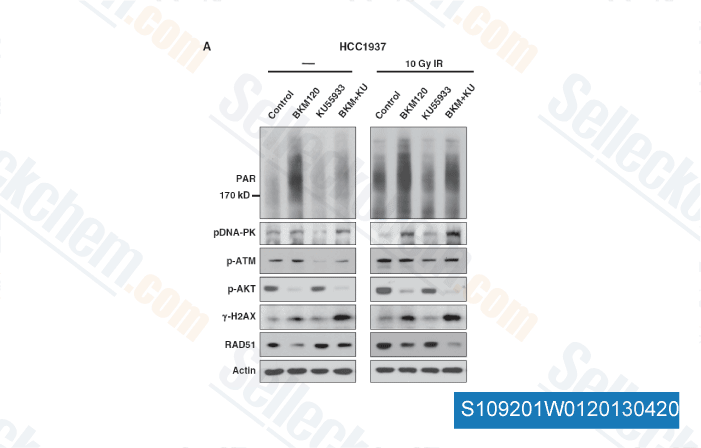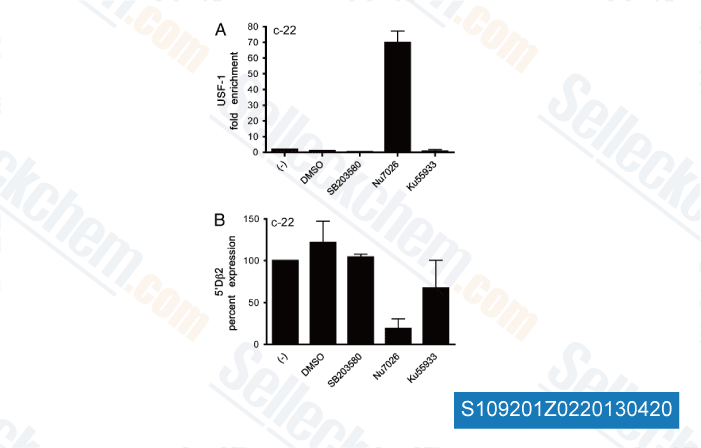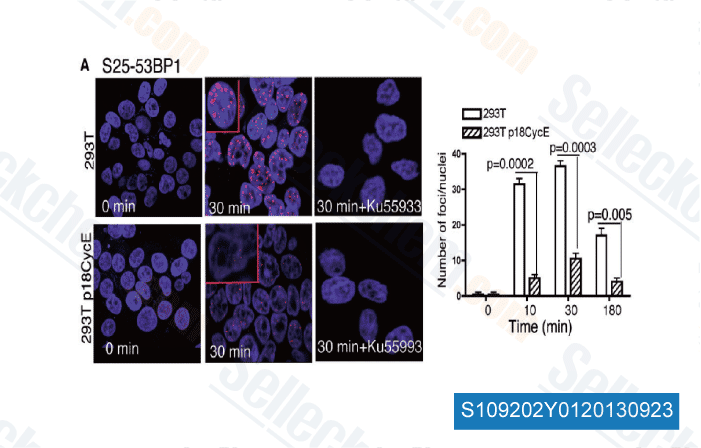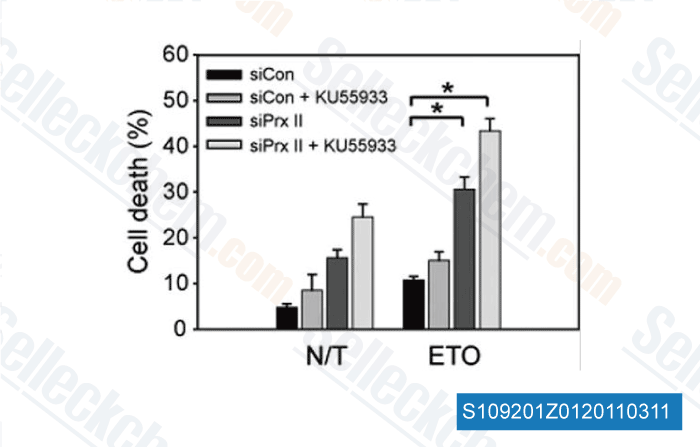|
Toll Free: (877) 796-6397 -- USA and Canada only -- |
Fax: +1-832-582-8590 Orders: +1-832-582-8158 |
Tech Support: +1-832-582-8158 Ext:3 Please provide your Order Number in the email. |
Technical Data
| Formula | C21H17NO3S2 |
||||||
| Molecular Weight | 395.49 | CAS No. | 587871-26-9 | ||||
| Solubility (25°C)* | In vitro | DMSO | 79 mg/mL (199.75 mM) | ||||
| Water | Insoluble | ||||||
| Ethanol | Insoluble | ||||||
| In vivo (Add solvents to the product individually and in order) |
|
||||||
|
* <1 mg/ml means slightly soluble or insoluble. * Please note that Selleck tests the solubility of all compounds in-house, and the actual solubility may differ slightly from published values. This is normal and is due to slight batch-to-batch variations. * Room temperature shipping (Stability testing shows this product can be shipped without any cooling measures.) |
|||||||
Preparing Stock Solutions
Biological Activity
| Description | KU-55933 is a potent and specific ATM inhibitor with IC50/Ki of 12.9 nM/2.2 nM in cell-free assays, and is highly selective for ATM as compared to DNA-PK, PI3K/PI4K, ATR and mTOR. KU‑55933 (ATM Kinase Inhibitor) inhibits the activation of autophagy‑initiating kinase ULK1 and results in a significant decrease of autophagy. | ||
|---|---|---|---|
| Targets |
|
||
| In vitro | KU-55933 inhibits DNA-PK and PI3K with IC50 of 2.5 μM and 16.6 μM, respectively. Besides, KU-55933 also prevents the activity of mTOR with IC50 of 9.3 μM. KU-55933 is active at the cellular level in ablating a well-characterized ATM-dependent phosphorylation event. KU-55933 has a dose-dependent effect in inhibiting this ATM-dependent phosphorylation event with IC50 of 300 nM. KU-58050 does not prevent the ATM-dependent phosphorylation of p53 serine 15 until a dose of 30 μM. Addition of KU-55933 has no appreciable effects on UV-induced phosphorylation of H2AX on serine 139, NBS1 on serine 343, CHK1 on serine 345, and SMC1 on serine 966. In stark contrast to the UV responses, KU-55933 ablates the ionizing radiation-induced phosphorylation of these ATM substrates. KU-55933 sensitizes HeLa cells to a range of ionizing radiation doses. [1] KU-55933 inhibits the phosphorylation of Akt induced by growth factors in cancer cells. KU-55933 suppresses the proliferation of cancer cells. Furthermore, suppression of ATM by KU-55933 improves survival, probably via prevention of downstream activation of TAp63α. [2] | ||
| In vivo | Suppression of ATM-dependent STAT3 activation by KU-55933 enhances TRAIL-mediated apoptosis through up-regulation of surface DR5 expression, whereas suppression of both STAT3 and NF-κB appeares to be involved in down-regulation of cFLIP accompanied by an additional increase in apoptotic levels. The ATM inhibitor KU-55933 affectes TRAIL-mediated apoptosis more strongly than the JAK2 inhibitor, AG490, or overexpression of STAT3β. [3] |
Protocol (from reference)
| Kinase Assay: |
|
|---|---|
| Cell Assay: |
|
| Animal Study: |
|
References
|
Customer Product Validation

-
Data from [Cancer Discov, 2012, 2, 1048-1063]

-
Data from [J Immunol, 2012, 188, 2266-2275]

-
Data from [Nucleic Acids Res, 2011, 41, 10157-69]

-
Data from [J Biol Chem, 2011, 286, 8394-8404]
Selleck's KU-55933 has been cited by 361 publications
| Comprehensive multi-omics analysis reveals WEE1 as a synergistic lethal target with hyperthermia through CDK1 super-activation [ Nat Commun, 2024, 15(1):2089] | PubMed: 38453961 |
| Kaposi's sarcoma herpesvirus exploits the DNA damage response to circularize its genome [ Nucleic Acids Res, 2024, gkad1224] | PubMed: 38180827 |
| Immunomodulatory effects and improved outcomes with cisplatin- versus carboplatin-based chemotherapy plus atezolizumab in urothelial cancer [ Cell Rep Med, 2024, 5(2):101393] | PubMed: 38280376 |
| FAK Drives Resistance to Therapy in HPV-Negative Head and Neck Cancer in a p53-Dependent Manner [ Clin Cancer Res, 2024, 30(1):187-197] | PubMed: 37819945 |
| SMARCAL1 ubiquitylation controls its association with RPA-coated ssDNA and promotes replication fork stability [ PLoS Biol, 2024, 22(3):e3002552] | PubMed: 38502677 |
| The ARID1A-METTL3-m6A axis ensures effective RNase H1-mediated resolution of R-loops and genome stability [ Cell Rep, 2024, 43(2):113779] | PubMed: 38358891 |
| Identification of the main barriers to Ku accumulation in chromatin [ bioRxiv, 2024, 2024.01.03.574002] | PubMed: 38260538 |
| Cyclin E-induced replicative stress drives p53-dependent whole-genome duplication [ Cell, 2023, 186(3):528-542.e14] | PubMed: 36681079 |
| ATM signaling modulates cohesin behavior in meiotic prophase and proliferating cells [ Nat Struct Mol Biol, 2023, 10.1038/s41594-023-00929-5] | PubMed: 36879153 |
| Mild replication stress causes premature centriole disengagement via a sub-critical Plk1 activity under the control of ATR-Chk1 [ Nat Commun, 2023, 14(1):6088] | PubMed: 37773176 |
RETURN POLICY
Selleck Chemical’s Unconditional Return Policy ensures a smooth online shopping experience for our customers. If you are in any way unsatisfied with your purchase, you may return any item(s) within 7 days of receiving it. In the event of product quality issues, either protocol related or product related problems, you may return any item(s) within 365 days from the original purchase date. Please follow the instructions below when returning products.
SHIPPING AND STORAGE
Selleck products are transported at room temperature. If you receive the product at room temperature, please rest assured, the Selleck Quality Inspection Department has conducted experiments to verify that the normal temperature placement of one month will not affect the biological activity of powder products. After collecting, please store the product according to the requirements described in the datasheet. Most Selleck products are stable under the recommended conditions.
NOT FOR HUMAN, VETERINARY DIAGNOSTIC OR THERAPEUTIC USE.
